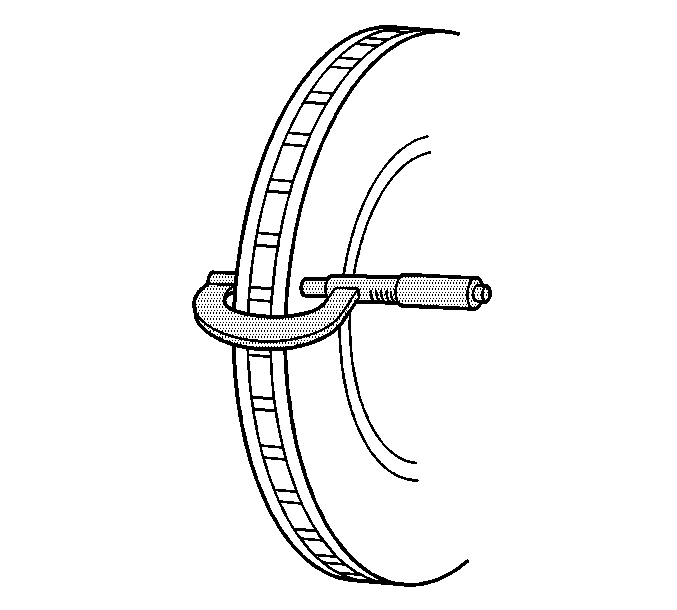Brake Rotor Thickness Measurement J57
Special Tools
CH-48897 Brake Rotor Scale
Thickness Measurement
Warning: Refer to Brake Dust Warning in the Preface section.
- Without disconnecting the brake hose fitting, remove the brake caliper and disc brake pads as an assembly and support with heavy mechanics wire or equivalent. Refer to Front Brake Caliper Replacement or Rear Brake Caliper Replacement.
- Clean the friction surfaces of the brake rotor with soap and water or denatured alcohol and allow to air dry.
- Using a micrometer calibrated in thousanths-of-a-millimeter, or ten-thousanths-of-an-inch, measure and record the thickness of the brake rotor at four or more points, evenly spaced around the rotor.
- Compare the lowest thickness measurement recorded to specifications. Refer to Disc Brake Component Specifications.
- If the lowest thickness measurement of the brake rotor is above the brake rotor discard thickness specification, the rotor may be able to be reused, depending upon surface and wear conditions which may be present.
- If the lowest thickness measurement of the brake rotor is at or below the brake rotor discard thickness specification, the rotor requires replacement.
Note: Do not clean the friction surfaces of the brake rotor with chemical brake cleaners.

Ensure that the measurements are only taken within the friction surfaces and that the micrometer is positioned the same distance from the outer edge of the rotor, about 13 mm (½ in), for each measurement.
Weight Measurement
- Matchmark the brake rotor relationship to the wheel hub and remove the brake rotor.
- Using a firm bristle brush, clean the friction surfaces of the brake rotor of all loose material.
- If necessary, carefully remove any loose material and debris from the cross-drilled holes in the brake rotor with a 5 mm (3/16 in) diameter tool.
- Ensure the brake rotor is thoroughly dry before attempting the weight measurement.
- Calibrate the CH-48897 Brake Rotor Scale , using the included calibration weight.
- Place the brake rotor on the CH-48897 Brake Rotor Scale .
- Compare the weight shown on the CH-48897 Brake Rotor Scale to the discard weight indicated on the carrier portion of the brake rotor.
- If the weight shown on the CH-48897 Brake Rotor Scale is at or below the discard weight indicated on the brake rotor, the rotor requires replacement.
- Perform the Brake Rotor Surface and Wear Inspection.
Note: Do not use a wire brush to clean the friction surfaces of the brake rotor.
Note: Do not pry against the cross-drilled holes in the brake rotor to remove loose material and debris.
Note: The CH-48897 Brake Rotor Scale must be calibrated using the included calibration weight prior to weighing each brake rotor.
Due to the construction of the brake rotor, each brake rotor will have a unique discard weight specification.
Brake Rotor Thickness Measurement JL9, J55, J56
Warning: Refer to Brake Dust Warning in the Preface section.
- If the inboard friction surface of the brake rotor is not accessible, reposition and support the caliper with the brake pads. Refer to Front Brake Caliper Replacement and/or Rear Brake Caliper Replacement.
- Clean the friction surfaces of the brake rotor with denatured alcohol, or an equivalent approved brake cleaner.
- Using a micrometer calibrated in thousanths-of-a-millimeter, or ten-thousanths-of-an-inch, measure and record the thickness of the brake rotor at four or more points, evenly spaced around the rotor.
- Compare the lowest thickness measurement recorded to specifications. Refer to Disc Brake Component Specifications.
- If the lowest thickness measurement of the brake rotor is above the minimum allowable thickness after refinishing specification, the rotor may be able to be refinished, depending upon surface and wear conditions which may be present.
- If the lowest thickness measurement of the brake rotor is at or below the minimum allowable thickness after refinishing specification, the rotor may not be refinished.
- If the lowest thickness measurement of the brake rotor is at or below the discard thickness specification, the rotor requires replacement.

Ensure that the measurements are only taken within the friction surfaces and that the micrometer is positioned the same distance from the outer edge of the rotor, about 13 mm (½ in), for each measurement.
